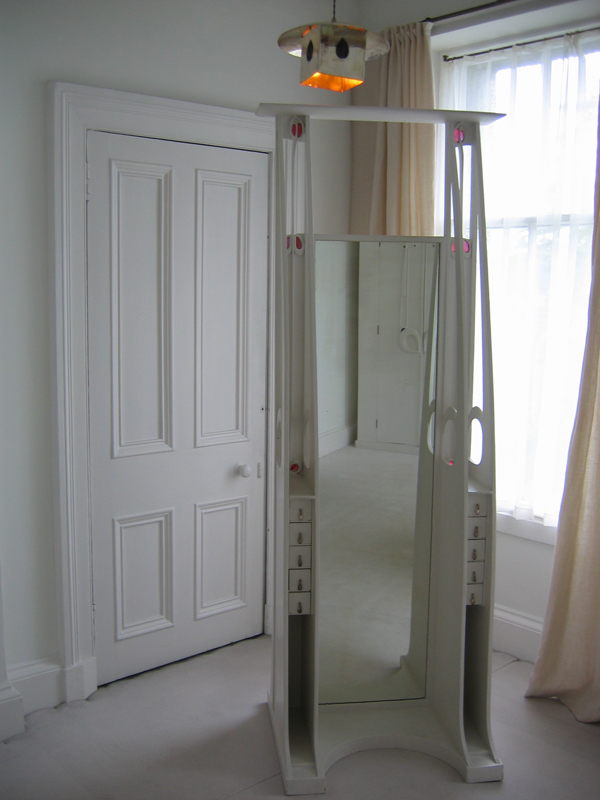The House for an Art Lover : Building the Dream of Charles Rennie Mackintosh –Part 1

Mackintosh House for an Art Lover © 2007 Scotiana
For Charles Rennie Mackintosh’s admirers it’s something to find oneself in front of this elegant white building with its emblematic façade, so representative of the artist’s style and to think it has been built, more than seventy years after his death! If they came back to earth, the Mackintoshes would certainly be the first to be surprised not only to see the house of their dreams proudly standing amidst a beautiful park, but also to see it there, in Bellahouston Park, in Glasgow.
For, after their disqualification at Darmstadt competition, in 1901, not only did they lose all their hopes to build the expensive House for an Art lover but, after a decade of popularity in the artistic circles, they fell into such disgrace in their home town and country that they decided to look for kinder climes, first in England and then in the south of France. But here, in the midst of Glasgow, stands the beautiful house, as a posthumous masterpiece of the great Glaswegian artists.
No better tribute could have been paid to them. Here’s the second part of this incredible story whose main protagonists are Charles Rennie Mackintosh and Margaret MacDonald, his wife and alter ego, but also Graham Roxburgh, a most fervent admirer of these great artists, without whom the dream could have never come true…

Mackintosh's House for an Art Lover South elevation drawing - Building the Dream - Graham Roxburgh 2006
So it was that, after a relatively short period of recognition in the artistic world, and following the undeserved fate of their genial designers, the fourteen Mackintoshes’ drawings for the Art Lover’s House, sunk into oblivion for a long time up to their discovery by Graham Roxburgh, the author of the book Building the Dream …
It had all begun in 1985 when Graham Roxburgh, looking for a new building to house his firm of consulting engineers, fell upon Craigie Hall, a beautiful old mansion which, as he soon discovered, happened to contain several examples of Mackintosh’s earliest work. The house had been built in 1873 to the designs of Glasgow architect John Honeyman and bought in 1893 by Sir Thomas Mason, the great Glasgow builder who had just completed the City Chambers in George Square.
Sir Thomas appealed to John Honeyman, now associated with John Keppie, for the decoration and enlargment of the house and some work was entrusted to young Charles Rennie Mackintosh. He was then aged 25 and had been employed by the architectural firm since 1889.
Graham Roxburgh immediately fell in love with the house, bought it and began to restore it to its original magnificence. It was a nice place to install offices so he partly used it for his own business and partly rented it to other companies, opening it some days to visitors.
This adventure awakened in him a natural taste for architecture and triggered a passion for the Mackintoshes’ art, which made him visit all sites devoted to them. During his visit of the Hunterian Gallery, among other treasures, he fell upon a folio containing the Mackintoshes’ drawings for the Art Lover’s House and they made a strong impression on him…
It was a bright June day in 1980 when I drove along the motorway towards Glasgow Airport. I was considering the acquisition of a new office for my expanding firm of consulting engineers.
Spotting some rhododendrons in flower at the Dumbreck exit, I changed lanes and turned left next to Bellahouston Park. Facing me was a sales board in the grounds of a mansion hidden by trees, so I immediately turned left again and discovered a property hidden amongst the trees of a neglected walled garden. The windows were boarded up and the building was in a state of considerable dilapidation. It had stood empty for over two years, the lead had been stripped from the roof and it was reaching a point where restoration might have been impossible. I did not know at this time that the house had recently been saved from demolition by the prompt A-Listing of the house as a ‘building of national architectural importance’.
Yet the house contained some of Glasgow’s finest late Victorian interiors including, as I found, examples of Mackintosh’s earliest surviving work – particularly his incredible organ case dominating the Music-Room. With all of this in mind, I moved quickly to purchase the property.
My interest in architecture, ‘inherited’ from my father, was greatly stimulated by the ownership of Craigie Hall. We had many a visit from Mackintosh enthusiasts and experts and each one seemed to discover details of the building which had not been apparent at first sight.
Seeking to increase my knowledge, I visited most of the Mackintosh sites including the Hunterian Gallery of the University of Glasgow. Pamela Robertson, the Curator, directed me to the archive containing numerous architectural drawings by Mackintosh. Among them was a folio of his competition designs for the House for an Art Lover. Untying the binding cords the drawings fell open at : “Sheet No 7 – ‘Living Room and Music Room’. Panels by Margaret MacDonald Mackintosh. Charles Rennie Mackintosh 1901”.
Snow can be inspiring …
In Building the Dream, Graham Roxburgh tells us how, one winter day in 1987, he suddenly had an idea which all Mackintosh’s admirers would qualify as genial: “A planned skiing trip to Cairngorm had been aborted due to snow and gales so, stuck in a snowdrift on the drive home, provided a useful two hours thinking time. ‘Why don’t we build the Art Lover’s House ?’ I mused, as I doodled with a ball point pen on the back of a used envelope.” Not everybody would have launched out into such a risky adventure but Graham Roxburgh was known as being “un homme de métier” with a very entrepreneurial mind and he did it.
Most of all, he had a strong motivation … the Mackintoshes’ dream had become his.
From its original design by Mackintosh, dating back to 1900, to its final realization in 1996 one can easily imagine how difficult it must have been to build the House for an Art Lover. Only fourteen drawings to begin with, and of a rare beauty, but some of them were incomplete and much more drawings would have been needed.
The first thing to do was to find a suitable site in Glasgow to build the house. Once more, Graham Roxburgh was lucky enough to fall upon such a place, let us say the ideal one, not far from Craigie Hall : “On an autumnal jog that same year [1987] through the neighbouring Bellahouston Park, I litterally ‘ran across’ a near perfect site on the location of the former Ibroxhill House, demolished some 80 years earlier but, amazingly, having all the principal features of the parkland site portrayed in the folio. It was time for Mackintosh’s dream to become a reality.”
If one accepts that the architect’s primary design is of mass, space, light and colour,
then there now exists a full-scale realization of Mackintosh’s astounding scheme.
(Graham Roxburgh – Building the Dream 2006)
But from dream to reality there is often more than one step !
Once the building site had been found, Graham Roxburgh had to get the authorization to build on it a private building as the place happened to be a public park, then he had to secure financial support for his project and finally to recruit a very qualified team of designers, artists and craftsmen.
Last but not least, the building work had to begin very quickly for the contract signed with the authorities stipulated that the Art Lover’s House should open in 1990, as an illustration of the cultural dynamism of Glasgow which had been nominated for the title of European City of Culture.
This was a big challenge but Graham Roxburgh took it up : “Three and a half years later the House and its interior were almost complete”.
It would have been only fair that, having devoted so much of his time, energy and money in the building of this house, Graham Roxburgh was allowed to lead the project up to its final conclusion in 1996. Sadly enough, due to a combination of unlucky circumstances, it was not the case.
Thanks to him, however, the House for an Art Lover will stand forever in the beautiful Bellahouston Park, as a unique testimony to the Mackintoshes’ artistic genius.
The re-discovery of Mackintosh as a design icon for Glasgow has provided the City with a brand image to match that of Antoni Gaudi in Barcelona. Mackintosh’s reputation as a designer has been central to the emergence of Glasgow as a tourist and cultural destination. The House for an Art Lover exceeded even my expectations by quickly becoming one of Glasgow’s iconic tourist and visitor attractions.
If you can find it, do read Building the Dream… it’s a very interesting story, full of information and lively anecdotes, illustrated by a lot of photos and reproductions of the Mackintoshes’ drawings. Also, if you can, go and visit the House for an Art Lover… Not having been able to visit it we’ve been lucky to find a very interesting little film. It’s worth the visit ! It’s all there : the drawing and living rooms, the music room, the oval rooms, the nursery room, the beautiful furniture, the lights and colours, the Mackintosh rose…etc…etc… Enjoy!
House of an Art Lover video was produced by Catswhiskerstours.co.uk
Musical arrangement by Jean-Claude Leducq of Scotiana.com
A bientôt.
Mairiuna.








Fantastic information about Charles Rennie MacIntosh and House for an Art Lover! Actually going there tomorrow – Monday 24th June 2024 for a wedding and I decided to do a bit of research. I’ve been before to the Tearoom – didn’t know it was only built in the 1990s…